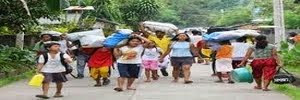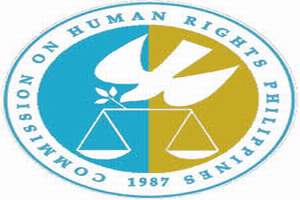PRRD Year 2: Gov’t committed to lift 6-M Filipinos out of poverty
PARTNERS FOR CHANGE. Some of President
Rodrigo R. Duterte's Cabinet officials join the pre-State of the Nation
Address (SONA) 2018 Forum at the Philippine International Convention
Center on Wednesday, July 11. (PNA photo)
MANILA
-- The government is committed to reduce poverty rate from 21 percent
to 14 percent or equivalent to lifting about six million Filipinos out
of poverty by 2022, an official of the Human Development and Poverty
Reduction Cluster (HDPRC) said.
“The roadmap to the challenges for all of us may be long but we stand committed towards our national target of lifting about six million Filipinos out of poverty,” HDPRC chair Virginia Orogo said in a pre-State-of-the-Nation Address (SONA) 2018 Forum at the Philippine International Convention Center.
Orogo, also acting secretary of the Department of Social Welfare and Development, said poverty alleviation is the main thrust of the Philippine Development Plan (PDP) 2017-2022.
The PDP 2017-2022 is geared towards the country’s long-term vision adopted in Executive Order No. 5 s. 2016, Ambisyon Natin 2040, which includes the eradication of poverty by 2040.
In pursuit of the HDPRC’s vision to improve the quality of life of the people, Orogo said the government has started addressing fundamental issues related to education, health, social protection and rural development.
She reported a 14.5 percent increase in enrollees in kindergarten and elementary education while over 4.9 million children of Pantawid Pamilya Program beneficiaries have been enrolled for academic year 2017-2018.
On the other hand, over 900,000 students in 112 State Universities and Colleges (SUCs) have benefited from the PHP8-billion grant of free tuition for 2017-2018 while nearly 300,000 poor students will benefit through the Unified Financial Assistance System for Tertiary Education (UNiFAST).
“By 2022, UNiFAST aims to increase the beneficiaries to 856,577,” Orogo said.
For 2018, a total of PHP672.4 billion has been allotted for education, including PHP40 billion for free tuition in SUCs.
In health advancement efforts, Orogo said 93 percent of Filipinos, particularly 32.7 million indigents, are now covered by PhilHealth while compliance rate in free check-ups and immunization services by pregnant women and children beneficiaries hit 97.44 percent.
Orogo also reported that 3,000 drug dependents have completed the Community Based Rehab Program while Medical Assistance for Indigents has served 751,007 clients.
She said the universal health coverage bill is expected to be passed soon in Congress after President Rodrigo R. Duterte certified it as an urgent measure.
The Duterte administration has allotted PHP167.9 billion for the health sector for 2018.
On enhanced social services, she said the beneficiaries of the Unconditional Cash Transfer (UCT) is expected to reach 8 million before Duterte’s third SONA on July 23.
She reported that government assistance has been provided to 16,559 repatriated overseas Filipino workers.
For rural development, Orogo said intensified support has been extended to farmers and fisherfolk to improve their capability through solar power irrigation system, national color-coded agricultural guide, “magsasakang mekaniko”, and livelihood interventions.
The Department of Agrarian Reform has distributed about 60,450 hectares of land to 53,805 beneficiaries while the Department of Agriculture has launched Easy Access Credit, where farmers and fisherfolk can borrow money with only six percent interest rates without collateral.
“Total amount release already reached Php1 billion with 96% repayment,” Orogo said.
She said 80 programs and services converge across 35 national line, attached and coordinative agencies as part of the Duterte administration’s goal to alleviate poverty, particularly in rural areas.
Based on HDPRC’s documents, poverty in the Philippines remains to be a predominantly rural phenomenon, with 75 percent of the poor residing in rural areas.
Among the basic sectors, poverty incidence is highest among farmers (34.3%) and fisherfolk (34%), far above the national average of 21.6 percent.
To achieve poverty reduction target, the HDPRC has set its focus on developing agriculture and industry, which are considered the most important sectors for job generation.
Orogo said the HDPRC will continue to exert all efforts to improve the quality of life of Filipinos by investing more in education, health, create more opportunities, increase social protection and community engagements and coordinate more at the local level.
However, Orogo emphasized that the government should get support from every Filipino to achieve a poverty-free Philippines by 2040.
“I then call on everyone around, present here or away, that we join hands together in our best efforts to support President Rodrigo Roa Duterte’s directives to help our Filipino people - especially the needy, disadvantaged, marginalized, and vulnerable sectors of our society towards making this nation great again,” she said. (PNA)
“The roadmap to the challenges for all of us may be long but we stand committed towards our national target of lifting about six million Filipinos out of poverty,” HDPRC chair Virginia Orogo said in a pre-State-of-the-Nation Address (SONA) 2018 Forum at the Philippine International Convention Center.
Orogo, also acting secretary of the Department of Social Welfare and Development, said poverty alleviation is the main thrust of the Philippine Development Plan (PDP) 2017-2022.
The PDP 2017-2022 is geared towards the country’s long-term vision adopted in Executive Order No. 5 s. 2016, Ambisyon Natin 2040, which includes the eradication of poverty by 2040.
In pursuit of the HDPRC’s vision to improve the quality of life of the people, Orogo said the government has started addressing fundamental issues related to education, health, social protection and rural development.
She reported a 14.5 percent increase in enrollees in kindergarten and elementary education while over 4.9 million children of Pantawid Pamilya Program beneficiaries have been enrolled for academic year 2017-2018.
On the other hand, over 900,000 students in 112 State Universities and Colleges (SUCs) have benefited from the PHP8-billion grant of free tuition for 2017-2018 while nearly 300,000 poor students will benefit through the Unified Financial Assistance System for Tertiary Education (UNiFAST).
“By 2022, UNiFAST aims to increase the beneficiaries to 856,577,” Orogo said.
For 2018, a total of PHP672.4 billion has been allotted for education, including PHP40 billion for free tuition in SUCs.
In health advancement efforts, Orogo said 93 percent of Filipinos, particularly 32.7 million indigents, are now covered by PhilHealth while compliance rate in free check-ups and immunization services by pregnant women and children beneficiaries hit 97.44 percent.
Orogo also reported that 3,000 drug dependents have completed the Community Based Rehab Program while Medical Assistance for Indigents has served 751,007 clients.
She said the universal health coverage bill is expected to be passed soon in Congress after President Rodrigo R. Duterte certified it as an urgent measure.
The Duterte administration has allotted PHP167.9 billion for the health sector for 2018.
On enhanced social services, she said the beneficiaries of the Unconditional Cash Transfer (UCT) is expected to reach 8 million before Duterte’s third SONA on July 23.
She reported that government assistance has been provided to 16,559 repatriated overseas Filipino workers.
For rural development, Orogo said intensified support has been extended to farmers and fisherfolk to improve their capability through solar power irrigation system, national color-coded agricultural guide, “magsasakang mekaniko”, and livelihood interventions.
The Department of Agrarian Reform has distributed about 60,450 hectares of land to 53,805 beneficiaries while the Department of Agriculture has launched Easy Access Credit, where farmers and fisherfolk can borrow money with only six percent interest rates without collateral.
“Total amount release already reached Php1 billion with 96% repayment,” Orogo said.
She said 80 programs and services converge across 35 national line, attached and coordinative agencies as part of the Duterte administration’s goal to alleviate poverty, particularly in rural areas.
Based on HDPRC’s documents, poverty in the Philippines remains to be a predominantly rural phenomenon, with 75 percent of the poor residing in rural areas.
Among the basic sectors, poverty incidence is highest among farmers (34.3%) and fisherfolk (34%), far above the national average of 21.6 percent.
To achieve poverty reduction target, the HDPRC has set its focus on developing agriculture and industry, which are considered the most important sectors for job generation.
Orogo said the HDPRC will continue to exert all efforts to improve the quality of life of Filipinos by investing more in education, health, create more opportunities, increase social protection and community engagements and coordinate more at the local level.
However, Orogo emphasized that the government should get support from every Filipino to achieve a poverty-free Philippines by 2040.
“I then call on everyone around, present here or away, that we join hands together in our best efforts to support President Rodrigo Roa Duterte’s directives to help our Filipino people - especially the needy, disadvantaged, marginalized, and vulnerable sectors of our society towards making this nation great again,” she said. (PNA)
PNA Website
links:
OTHER HUMAN RIGHTS PROMOTIONS WEBSITES
PROTECTION AND PROMOTION OF HUMAN RIGHTS
-----------------------------------------------------------------------------------------------
------------------------------------------------------------
-----------------------------------
-----------------------------------


























































0 comments:
Post a Comment